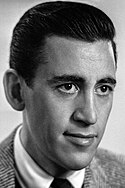J.D. Salinger Quote
Walt, at about eleven, had a routine of looking at Seymour's wrists and telling him to take off his sweater. Take off your sweater, hey, Seymour. Go ahead, hey. It's warm in here. S. would beam back at him, shine back at him. He loved that kind of horseplay from any of the kids. I did, too, but only off and on. He did invariably. He thrived, too, waxed strong, on all tactless or underconsidered remarks directed at him by family minors. In 1959, in fact, when on occasion I hear rather nettling news of the doings of my youngest brother and sister, I think on the quantities of joy they brought S. I remember Franny, at about four, sitting on his lap, facing him, and saying, with immense admiration, Seymour, your teeth are so nice and yellow! He literally staggered over to me to ask if I'd heard what she said.
Walt, at about eleven, had a routine of looking at Seymour's wrists and telling him to take off his sweater. Take off your sweater, hey, Seymour. Go ahead, hey. It's warm in here. S. would beam back at him, shine back at him. He loved that kind of horseplay from any of the kids. I did, too, but only off and on. He did invariably. He thrived, too, waxed strong, on all tactless or underconsidered remarks directed at him by family minors. In 1959, in fact, when on occasion I hear rather nettling news of the doings of my youngest brother and sister, I think on the quantities of joy they brought S. I remember Franny, at about four, sitting on his lap, facing him, and saying, with immense admiration, Seymour, your teeth are so nice and yellow! He literally staggered over to me to ask if I'd heard what she said.
Related Quotes
She was a gypsy, as soon as you unravelled the many layers to her wild spirit she was on her next quest to discover her magic. She was relentless like that, the woman didn't need no body but an open r...
About J.D. Salinger
The Catcher in the Rye (1951) was an immediate popular success; Salinger's depiction of adolescent alienation and loss of innocence was influential, especially among adolescent readers. The novel was widely read and controversial, and its success led to public attention and scrutiny. Salinger became reclusive, publishing less frequently. He followed Catcher with a short story collection, Nine Stories (1953); Franny and Zooey (1961), a volume containing a novella and a short story; and a volume containing two novellas, Raise High the Roof Beam, Carpenters and Seymour: An Introduction (1963). Salinger's last published work, the novella Hapworth 16, 1924, appeared in The New Yorker on June 19, 1965.
Afterward, Salinger struggled with unwanted attention, including a legal battle in the 1980s with biographer Ian Hamilton and the release in the late 1990s of memoirs written by two people close to him: Joyce Maynard, an ex-lover; and his daughter, Margaret Salinger.
